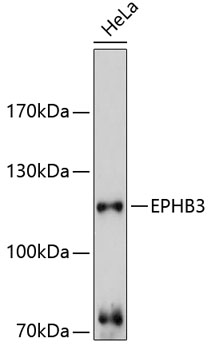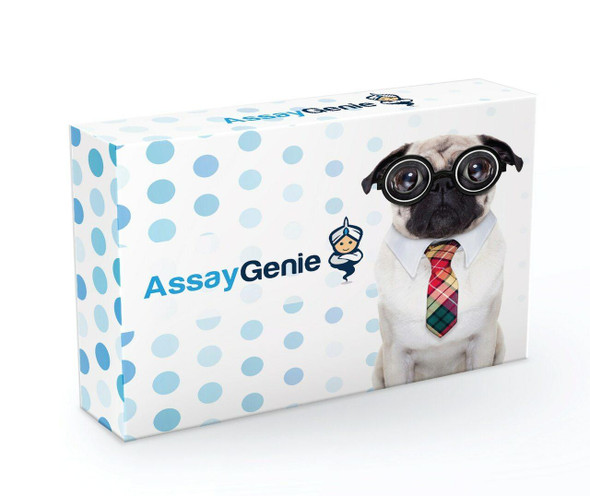Cardiovascular Antibodies
Anti-EPHB3 Antibody (CAB10214)
- SKU:
- CAB10214
- Product Type:
- Antibody
- Reactivity:
- Human
- Reactivity:
- Mouse
- Reactivity:
- Rat
- Host Species:
- Rabbit
- Isotype:
- IgG
- Antibody Type:
- Polyclonal Antibody
- Research Area:
- Cardiovascular
Description
| Antibody Name: | Anti-EPHB3 Antibody |
| Antibody SKU: | CAB10214 |
| Antibody Size: | 20uL, 50uL, 100uL |
| Application: | WB |
| Reactivity: | Human, Mouse, Rat |
| Host Species: | Rabbit |
| Immunogen: | Recombinant fusion protein containing a sequence corresponding to amino acids 270-560 of human EPHB3 (NP_004434.2). |
| Application: | WB |
| Recommended Dilution: | WB 1:500 - 1:2000 |
| Reactivity: | Human, Mouse, Rat |
| Positive Samples: | HeLa |
| Immunogen: | Recombinant fusion protein containing a sequence corresponding to amino acids 270-560 of human EPHB3 (NP_004434.2). |
| Purification Method: | Affinity purification |
| Storage Buffer: | Store at -20'C. Avoid freeze / thaw cycles. Buffer: PBS with 0.02% sodium azide, 50% glycerol, pH7.3. |
| Isotype: | IgG |
| Sequence: | TCAT GHEP AAKE SQCR PCPP GSYK AKQG EGPC LPCP PNSR TTSP AASI CTCH NNFY RADS DSAD SACT TVPS PPRG VISN VNET SLIL EWSE PRDL GGRD DLLY NVIC KKCH GAGG ASAC SRCD DNVE FVPR QLGL TERR VHIS HLLA HTRY TFEV QAVN GVSG KSPL PPRY AAVN ITTN QAAP SEVP TLRL HSSS GSSL TLSW APPE RPNG VILD YEMK YFEK SEGI ASTV TSQM NSVQ LDGL RPDA RYVV QVRA RTVA GYGQ YSRP AEFE TTSE RGSG AQQL QEQL PLI |
| Gene ID: | 2049 |
| Uniprot: | P54753 |
| Cellular Location: | Cell membrane, Cell projection, Single-pass type I membrane protein, dendrite |
| Calculated MW: | 110kDa |
| Observed MW: | 110kDa |
| Synonyms: | EPHB3, EK2, ETK2, HEK2, TYRO6 |
| Background: | Ephrin receptors and their ligands, the ephrins, mediate numerous developmental processes, particularly in the nervous system. Based on their structures and sequence relationships, ephrins are divided into the ephrin-A (EFNA) class, which are anchored to the membrane by a glycosylphosphatidylinositol linkage, and the ephrin-B (EFNB) class, which are transmembrane proteins. The Eph family of receptors are divided into two groups based on the similarity of their extracellular domain sequences and their affinities for binding ephrin-A and ephrin-B ligands. Ephrin receptors make up the largest subgroup of the receptor tyrosine kinase (RTK) family. This gene encodes a receptor for ephrin-B family members. |
| UniProt Protein Function: | EphB3: a ubiquitous receptor tyrosine kinase of the Eph family. A receptor for ephrin-B family members: ephrin-B1 and -B2. The Eph receptor tyrosine kinase family, the largest in the tyrosine kinase group, has fourteen members. They bind membrane-anchored ligands, ephrins, at sites of cell-cell contact, regulating the repulsion and adhesion of cells that underlie the establishment, maintenance, and remodeling of patterns of cellular organization. Eph signals are particularly important in regulating cell adhesion and cell migration during development, axon guidance, homeostasis and disease. EphA receptors bind to GPI-anchored ephrin-A ligands, while EphB receptors bind to ephrin-B proteins that have a transmembrane and cytoplasmic domain. Interactions between EphB receptor kinases and ephrin-B proteins transduce signals bidirectionally, signaling to both interacting cell types. Eph receptors and ephrins also regulate the adhesion of endothelial cells and are required for the remodeling of blood vessels.EphB3 contains 1 sterile alpha motif (SAM) domain and 2 fibronectin type III domains. |
| UniProt Protein Details: | Protein type:EC 2.7.10.1; Protein kinase, TK; Kinase, protein; Membrane protein, integral; Protein kinase, tyrosine (receptor); TK group; Eph family Chromosomal Location of Human Ortholog: 3q27.1 Cellular Component: integral to plasma membrane; dendrite; plasma membrane; extracellular region; cytosol Molecular Function:ephrin receptor activity; axon guidance receptor activity; ATP binding Biological Process: axon guidance; cell migration; peptidyl-tyrosine phosphorylation; thymus development; protein amino acid autophosphorylation; axonal fasciculation; central nervous system projection neuron axonogenesis; digestive tract morphogenesis; palate development; regulation of axonogenesis; corpus callosum development; positive regulation of synaptogenesis; regulation of cell-cell adhesion; ephrin receptor signaling pathway; angiogenesis; urogenital system development; retinal ganglion cell axon guidance |
| NCBI Summary: | Ephrin receptors and their ligands, the ephrins, mediate numerous developmental processes, particularly in the nervous system. Based on their structures and sequence relationships, ephrins are divided into the ephrin-A (EFNA) class, which are anchored to the membrane by a glycosylphosphatidylinositol linkage, and the ephrin-B (EFNB) class, which are transmembrane proteins. The Eph family of receptors are divided into two groups based on the similarity of their extracellular domain sequences and their affinities for binding ephrin-A and ephrin-B ligands. Ephrin receptors make up the largest subgroup of the receptor tyrosine kinase (RTK) family. This gene encodes a receptor for ephrin-B family members. [provided by RefSeq, Mar 2010] |
| UniProt Code: | P54753 |
| NCBI GenInfo Identifier: | 76803655 |
| NCBI Gene ID: | 2049 |
| NCBI Accession: | P54753.2 |
| UniProt Related Accession: | P54753 |
| Molecular Weight: | |
| NCBI Full Name: | Ephrin type-B receptor 3 |
| NCBI Synonym Full Names: | EPH receptor B3 |
| NCBI Official Symbol: | EPHB3 |
| NCBI Official Synonym Symbols: | EK2; ETK2; HEK2; TYRO6 |
| NCBI Protein Information: | ephrin type-B receptor 3 |
| UniProt Protein Name: | Ephrin type-B receptor 3 |
| UniProt Synonym Protein Names: | EPH-like tyrosine kinase 2; EPH-like kinase 2; Embryonic kinase 2; EK2; hEK2; Tyrosine-protein kinase TYRO6 |
| Protein Family: | Ephrin type-B receptor |
| UniProt Gene Name: | EPHB3 |
| UniProt Entry Name: | EPHB3_HUMAN |







